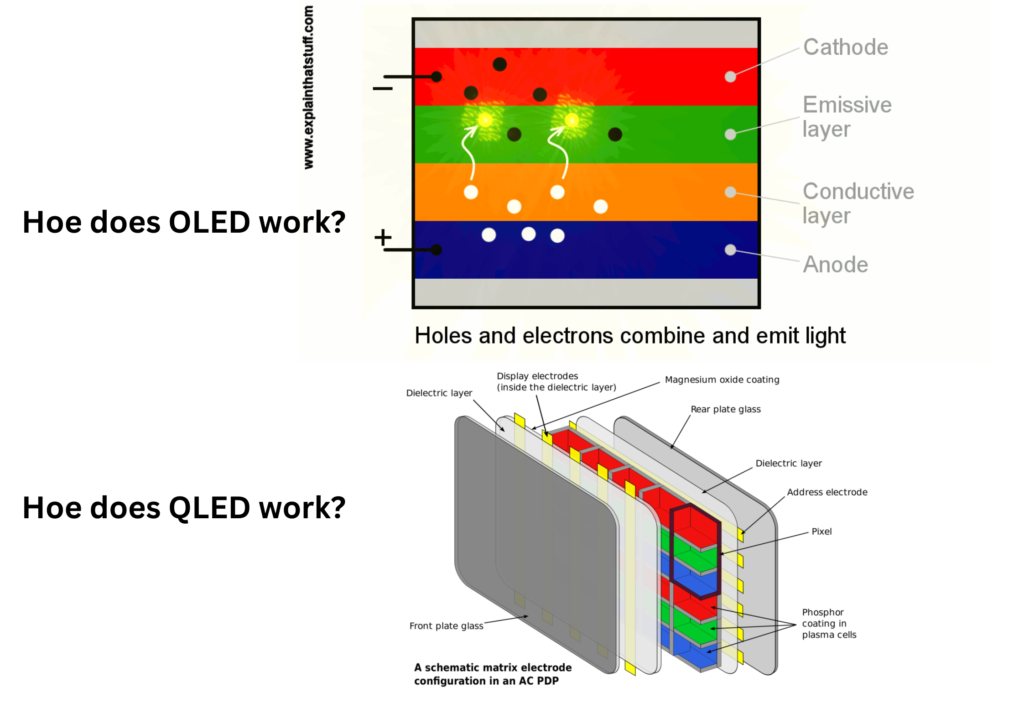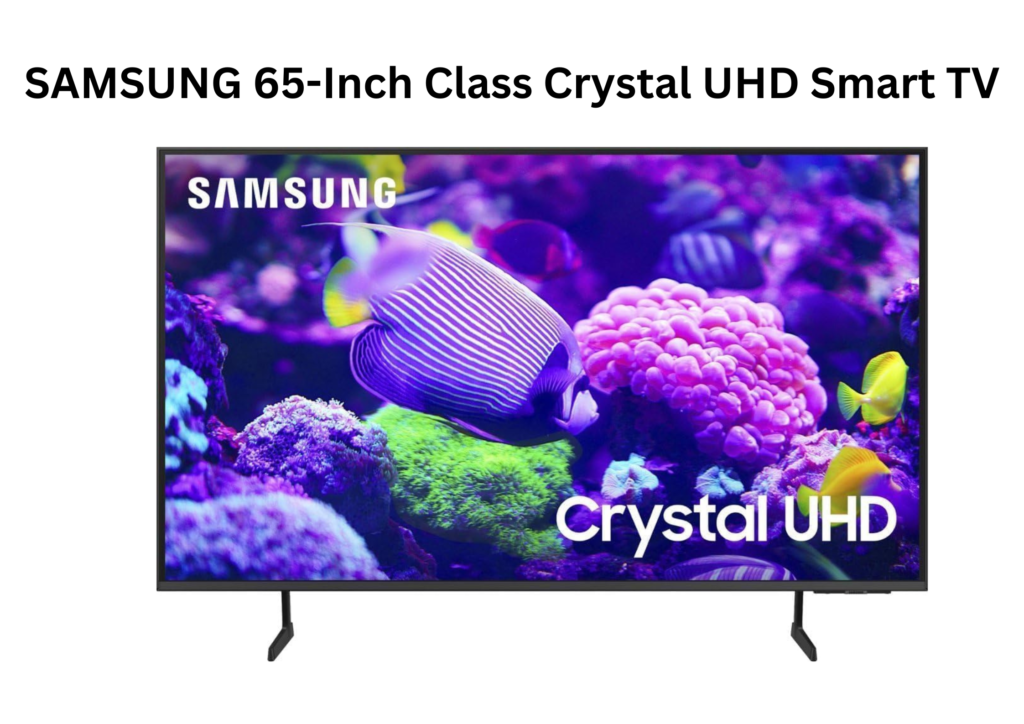When you shop for a new TV, you will come across options and technologies like LED, QLED, and OLED. All these technologies are different with corresponding pros and cons. If you see them on display, you will find all look the same. Then what’s the difference between them? Which TV should you buy?
The implementation of different technologies will result in different types of displays which again affect the picture quality of your TV. So, before buying the best one you should know the real difference between all these technologies. To help you in making the best choice a side-by-side comparison table about OLED Vs QLED Vs LED is represented here.
Read the full article to select the best display for your home theater setup.
OLED technology
What is OLED technology?
The OLED refers to an Organic Light-emitting Diode. In OLED technology a series of organic thin films are placed between two conductors. When we give an electric supply to it, a bright light is emitted. OLED is a solid-state device and the display is made of organic molecules. The material used in the OLED display contains carbon plus some other ingredients.
OLED technology is a flat-emitting technology. Here each pixel is built with a material that glows when electricity is applied to it. In OLED technology the intensity is controlled by controlling the electric current applied by the electrodes and the light’s color depends on the type of various organic molecules used in the display.
How does OLED work?
The displays that are designed by using OLED technology are very light and they can produce brighter and more colorful pictures. The OLED technology is based on the LED technique. The main difference in OLED is the light produced here by using organic molecules. In chemistry organic molecules are made of carbon and can include other common things like gasoline, plastics, natural gas, sugar, wood, alcohol, etc.
- The OLED has six different layers. The top layer is called the seal. The last layer is known as the substrate. Both of these layers are made of protective glass or plastic.
- In between the top and bottom layer there is a positive terminal known as anode and a negative terminal known as cathode.
- Inside the cathode and anode there are two layers made of organic molecules. These layers are known as the emissive layer and conductive layer. The emissive layer presents next to the cathode and the light is produced in this layer. The conductive layer presents next to the anode.
- When a voltage is applied across the anode and cathode, electricity starts flowing. Here the cathode receives electrons and the anode receives holes.
- The added electrons make the emissive layer negatively charged, while the conductive layer is positively charged.
- The positive holes then start jumping from the conductive layer to the emissive layer. Then the process of recombination starts. When the hole meets with the electron it cancels out and releases energy in the form of light or a photon.
- In this process the OLED technology emits light.
Advantages and disadvantages of OLED technology
Advantages:
- OLEDs are very thin, lightweight, and flexible.
- OLEDs consume less power as they generate light directly.
- As OLED uses organic molecules, they are brighter than LEDs.
- OLEDs have a faster response time.
- OLEDS have large viewing angles and better contrast ratios than LEDs.
Disadvantages:
- OLEDs have a shorter lifespan due to the organic materials used in their construction. With time the organic material degrades which results in corresponding degradation in color and brightness.
- OLED devices are generally expensive.


QLED technology
What is QLED technology?
QLED refers to a Quantum Dot Light Emitting Diode. The main difference between a regular LED display and a QLED display is that QLED has an extra quantum dot layer in its design. The QLED display uses quantum dots and semiconductor nanocrystals to produce several monochromatic lights.
QLED technology is used to enhance the picture quality. In this technology, quantum dots are excited to emit pure basic colors. It reduces light losses and color crosstalk to improve the brightness level of the display.
How does QLED technology work?
Quantum dots are microscopic molecules. The diameter of these quantum dots ranges from 2 to 10 nanometers. Based on the size it produces different colors. These quantum dots are contained in a film. Quantum dots are able to produce various colors of light when they are hit by the light provided by the LED backlight. The light is then passed through several other layers including the LCD layer to create the picture.
Advantages and disadvantages of QLED technology
Advantages:
- It offers a wide variety of colors with good color accuracy.
- QLED display provides better brightness.
- It provides a large variety of screen sizes.
- QLED displays are affordable.
- There is no risk of burn-in so QLED displays are durable and offer a greater lifespan.
Disadvantages
- Inferior viewing angles
- Usually, the thickness of QLED display devices is greater and they look bulkier.
- Higher response time
- Slower refresh rate
- Blacks are not perfect

LED technology
What is LED technology?
LED stands for Light Emitting diode. A diode consists of two electrodes, a cathode and an anode. The diose is made of semiconductive material like silicon. When an electric supply is given, electric current flows through it and it emits visible light. So LED is a semiconductor device that emits light when an electric current passes through it.
Basically, LEDs are tiny light bulbs that use less electricity and they don’t get especially hot. Their life span is longer as they don’t burn out like filament bulbs. This LED technology is environmentally friendly as it saves energy, produces less heat, has a greater life span, and is also recyclable.
How does LED work?
- LED is a semiconductor device that consists of N-type material and P-type material bonded together with electrodes on each end.
- A semiconductor with an extra electron is known as N-type material and the extra hole is known as P-type material.
- When a voltage source is applied, that is N-type area of the diode is connected to the negative end of the circuit and the P-type area of the diode to the positive end of the circuit, then the electron starts moving from the N-type area to P-type area and holes move in the opposite direction.
- When there is an interaction between the electrons and holes, energy is generated in the form of photons or, visible light.
Advantages and disadvantages of LED technology
Advantages:
- LEDs are energy-efficient devices and they consume less electricity.
- LEDs don’t burn out and thus they last longer than other types of lighting devices.
- LED lights are environmentally friendly as they produce less heat and also they are recyclable.
- LEDs are highly durable and need less maintenance.
- It offers superior light quality.
- LEDs are used in various applications including residential, commercial, outdoor, horticultural, etc.
Disadvantages:
- LEDS are a little bit expensive.
- If not designed properly they are highly susceptible to damage.
- LEDs are highly sensitive to voltage and current.

Comparison Table of OLED vs QLED vs LED technology
| OLED | QLED | LED | |
| Full Name | Organic Light Emitting Diode | Quantum dot Light Emitting Diode | Light Emitting Diode |
| Working Principle | OLED TV does not need any backlight. It produces lights with its diodes inheriting organic properties. | QLED TV needs an LED backlight to hit the Quantum dot layer to produce light. | LED TV requires a backlighting setup to produce lights |
| Brightness | It has a peak brightness of around 500-800 nits. | QLED is the Brightest TV with a brightness of around 4000 nits. | LED TV is twice as bright as OLED TV with brightness of 1000-2000 nits. |
| Contrast | Features a high contrast ratio and can produce “pure blacks” and the richest colors. | Offers a lesser contrast ratio. | Offers a lesser contrast ratio. |
| Color Accuracy | Color accuracy is lower than QLED. | QLED can display a wider range of colors with good color accuracy. | Color accuracy is lower than QLED. |
| Response Time | OLED is capable of changing the pixel instantaneously on the screen. It features better response time. | Response time is more than OLED. | Response time is more than OLED. |
| Viewing Angles | OLED offers a great viewing experience with the widest viewing angles. | With a distance, it suffers from lost color. | The viewing angle is not that wide. |
| Cost | More expensive than LED TV | QLED TVs are little more expensive than LED TV but they offer the best value for money. | Less expensive |
LED or OLED or QLED TV which one should you Consider?
Choosing the perfect TV for your smart home is really difficult. It depends on your personal choice, preferences, and budget. To make you feel easier in the selection process between LED, OLED, and QLED TVs, we have compared all these techniques in the best possible way.
The traditional LED TVs are cost-effective and they are a good option for everyday TV binging. If your budget is high and you want the best picture-quality display then you should go for OLED TV. OLED TVs feature a high contrast ratio, low response time, and widest viewing angles. QLED TVs are a balanced option between LED and OLED TVs. QLED TVs provide great features like high brightness than both LED and OLED and a wide range of color accuracy at an affordable price.
FAQS
- Which is better OLED or LED?
OLED technology is better than LED technology. OLED TVs offer great features like high contrast ratio, best picture quality, lower response time, and widest viewing angles. Whereas, LED TVs feature a lower contrast ratio, higher response time and the viewing angle is not that much wider.
2. Is OLED worth the extra money?
Yes, OLED TVs are worth the extra money. OLED TVs are superior and are more expensive than LED and QLED TVs. These TVs offer the best picture quality, with lower response time and widest viewing angles. The self-illuminating pixels of OLED TVs produce their own light and this is the reason why these products are costly. But the amazing picture quality offered by OLED TVs worth the extra money.
Also Read
- 6 Latest Lighting Technology for Homes
- How To Set Up Smart Lighting at Home?
- How to control lights away from home? A Complete Guide 2024
- Easy Steps to Fix and Replace LED Light Bulbs 2024
- 7 Latest Trends in LED lighting (2024)
- How Do Portable Air Conditioners Work Without a Window? 2024
- Portable AC Vs Window AC: Which One Is Right for You? 7 Major Differences
- Portable AC Vs Central AC: Which One Is Right for You? 2024
- Is Central AC Good for Home?
- Why Are HVAC Systems So Expensive? 10 Most Common Reasons
- What Size of HVAC System Do I Need? 2024
- What Is the Most Efficient HVAC System and Why? 2024
- Types of HVAC Systems in Apartments 2024
- HVAC System Working Principle
- HVAC System Vs Air Conditioning System: 6 Major Differences
- What Are the Most Common Types of HVAC Systems? 2024
- 6 Types of HVAC Systems for Homes 2024
- How Does a Refrigerator Work? A Step-by-Step Guide 2024
- 8 Reasons Why Refrigerator Not Cooling and Solutions
- Side By Side Vs French Door Refrigerator 2024
- Counter Depth Refrigerator vs. Standard Refrigerator: Which One Is Better?
- Where Should I Place My Air Purifier? 2024
- How Do You Know If You Need an Air Purifier? 2024
- HEPA Air Purifier: Definition, Types, Uses, Efficiency, Working Principle
- Whole House Air Purifier: Types, Pros, Cons, Working Principle 2024


9 thoughts on “OLED vs QLED vs LED: A Detailed Guide 2025”